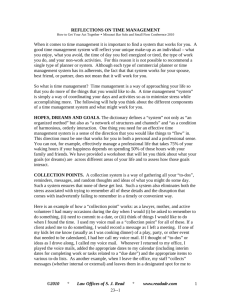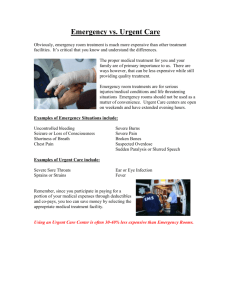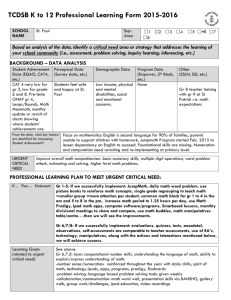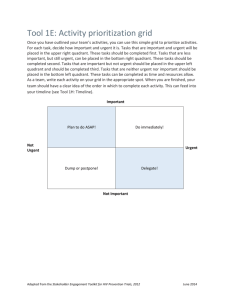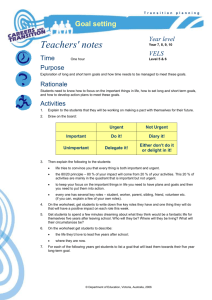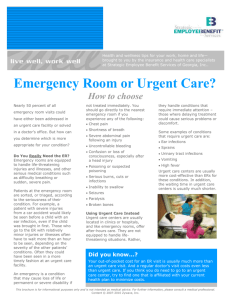Time Management in the Maintenance Pressure Cooker
advertisement
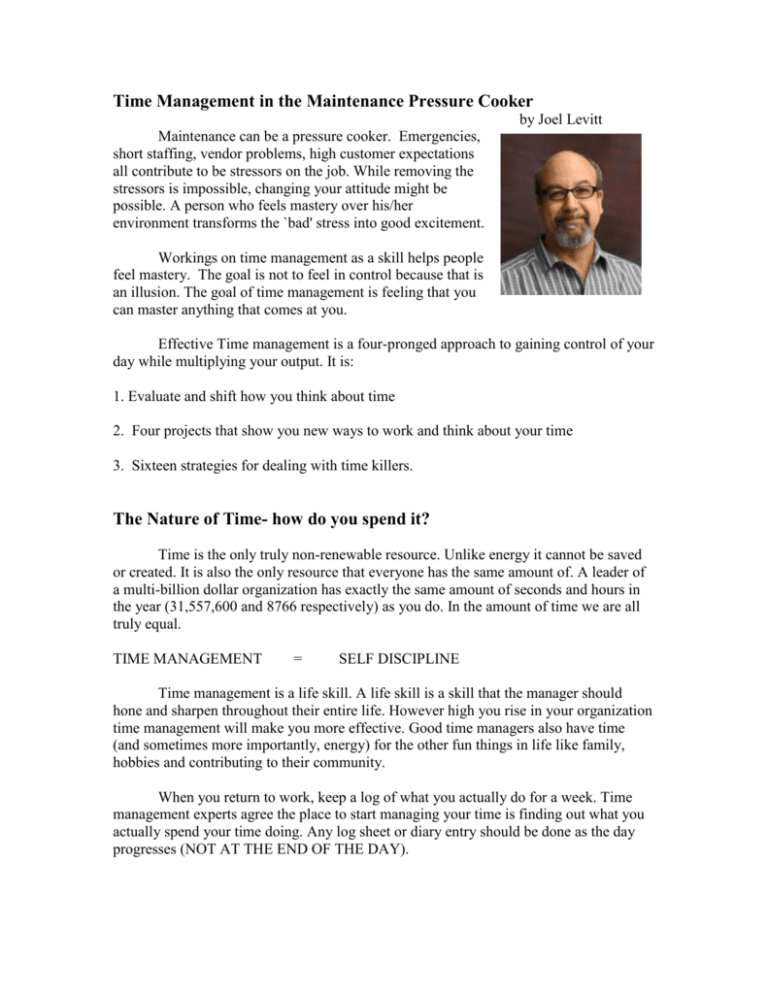
Time Management in the Maintenance Pressure Cooker by Joel Levitt Maintenance can be a pressure cooker. Emergencies, short staffing, vendor problems, high customer expectations all contribute to be stressors on the job. While removing the stressors is impossible, changing your attitude might be possible. A person who feels mastery over his/her environment transforms the `bad' stress into good excitement. Workings on time management as a skill helps people feel mastery. The goal is not to feel in control because that is an illusion. The goal of time management is feeling that you can master anything that comes at you. Effective Time management is a four-pronged approach to gaining control of your day while multiplying your output. It is: 1. Evaluate and shift how you think about time 2. Four projects that show you new ways to work and think about your time 3. Sixteen strategies for dealing with time killers. The Nature of Time- how do you spend it? Time is the only truly non-renewable resource. Unlike energy it cannot be saved or created. It is also the only resource that everyone has the same amount of. A leader of a multi-billion dollar organization has exactly the same amount of seconds and hours in the year (31,557,600 and 8766 respectively) as you do. In the amount of time we are all truly equal. TIME MANAGEMENT = SELF DISCIPLINE Time management is a life skill. A life skill is a skill that the manager should hone and sharpen throughout their entire life. However high you rise in your organization time management will make you more effective. Good time managers also have time (and sometimes more importantly, energy) for the other fun things in life like family, hobbies and contributing to their community. When you return to work, keep a log of what you actually do for a week. Time management experts agree the place to start managing your time is finding out what you actually spend your time doing. Any log sheet or diary entry should be done as the day progresses (NOT AT THE END OF THE DAY). Other strategies for finding out how you spend your time include some simple technology. One of the most effective methods to track activity is work sampling. The key to work sampling is to randomly note your own activity throughout the day. Each time note the activity at the instant of the random time. Conway Quality, a firm in Nashua, New Hampshire, has developed an entire productivity improvement program designed around a random time beeper. This beeper will beep randomly throughout the day. On specially designed pads you record your activity. Reality of being a maintenance supervisor: The reality of the field of maintenance is that frequently we are not in control of our time. Please note that when we are not in control of most of our time it is doubly important to control what little time is left. Four projects to improve your time management Project #1 Clean your desk, organize your office. This can be a biggie so schedule it. A. Set aside a length of time when you won't be interrupted. B. Get an entire box of manila folders. Put them in order with the tabs alternating leftcenter-right-left-center-right... C. Get a blank piece of paper (full sized) for your master To-Do list. D. Put all of your papers in a pile. Include the little half, quarter sheets, envelopes, napkins and everything else you were going to get to. E. Go through every piece of paper and be ruthless about throwing as much as possible away. Separate into a new pile the papers you need to keep. If there is an action that needs to be taken save the paper in this new pile. F. Back to the grindstone. Start with the top paper and ask yourself some simple questions, is there any work that must be done? Add that assignment to your master to-do list. Should I keep the piece of paper? Remember you recorded the assignment. If it’s a keeper and no file already exists prepare a manila folder. Keep this up until you reach the bottom of the pile. Do not do the work now unless it can be handled within 1-2 minutes. G. Remove all office supplies such as tape, staplers, and paper clip collections from the surface of your desk. Attack any surface of your office that accumulates papers for more than a very short time (the paper turns over in 1 shift). H. You now have a clean desk. You also have a completed to-do list that could be up to several pages long. You will find that a clean desk encourages efficient work habits. You put your work on your desk; complete it to the level possible at that time, put it back into its proper files, and have a clean desk once again. Project #2, Super-charge your time. A. Look at areas where you could do two things at once without sacrificing quality of either. Example would be the twice-daily commute. An hour commute could translate into over 200 hours a year of learning time through use of cassettes. Remember that 200 hours is equivalent to 3 college level courses (homework time included). Ideas: waiting for meetings, waiting for airplanes, driving, exercising, taking a bath, mowing lawn, etc. B. Carry a micro cassette recorder to record ideas, memos, letters and instructions. This is an excellent idea if you have staff support to transcribe your tapes. The transcription should use a separate page for ideas on each project to be filed in the project file. Your brain is your most powerful tool. C. Use your crew to delegate some of your tasks to. A well-trained crew will multiply your effectiveness. D. Learn to type and use a computer. Once you learn, you will type as fast or faster than you write with less fatigue and greater accuracy. E. Use fax machines or get a scanner and use E-mail to transmit ideas (particularly drawings) to remote sites, vendors, users. Both are faster than mail and more accurate than any verbal descriptions. Get your watch out and time your reading of the next paragraph and don’t cheat! G. Learn to speed-read. If you think that it is a waste of time try this: Time your reading speed. Read this whole paragraph to the bottom of the page fairly closely at your normal reading speed. Note the elapsed time. Divide the total word count (106) by the number of seconds and multiply by 60. A good fast pace is 400 words per minute with good comprehension. Speed-readers top out at 1500 to 2000 words per minute. Many maintenance supervisors read at 100 or less words per minute. How much more could you read if you could read at 1000 wpm? Check below. Time... (Note: Paragraph G has 107 words. A speed-reader would have completed it in 6-10 seconds.) Project #3 The 80/20 Rule An Italian economist, Preato, discussed an in-formal rule that few members of any population (he worked on wealth in 19th century Italy) are responsible for most of the action. Now called the Preato principle or the 80/20 rule. It can be stated for most management situations as 80% of the action comes from only 20% of the actors. We find that 80% of our employee problems come from 20% of our employees, 80% of our emergencies come from less than 20% of the equipment. Since 80% of our results will flow from 20% of our activities, if we identify these critical few activities and increase our time commitment to these activities we can double or triple our results each day. Your exercise is to go through your master to-do list and examine each item. Divide the items into a 20% important and (we call them) highly leveraged activity and the 80% low leverage activity. The 20% activities should be scheduled first during your high-energy intervals throughout the day. The top three of these activities become your bottom lines. The bottom line is `if you do nothing else today, you will do your bottom lines'. The low return on investment activities, the 80% activities will fill-in around the 20% activities. For another look at setting priorities look at the work of Stephen Covey in the next section. *****Beware of the tyranny of the URGENT. *****Remember, "You are paid for what you complete not what you start. One of the greatest thinkers and consultants of this era is Dr. Stephen R. Covey. In his excellent books he describes a new way to sort out events that exactly corresponds to good maintenance practices. His model reproduced below describes 4 kinds of incoming tasks divided up by two categories: 1. Important -Urgent 3. Important- Not Urgent 2. Unimportant- Urgent 4. Unimportant- Not urgent The 4 types of tasks are: 1. Important-Urgent, 2. Unimportant-urgent, 3. Important-Not Urgent, 4. Unimportant-Not Urgent. Type 1: Most maintenance managers are already excellent at category number one. This is called fire fighting. I've never yet met a maintenance professional that would say they were not great fire fighters. The bad fire fighters probably get winnowed out and go into an allied profession that doesn't have as many crises. You need to be an effective fire fighter to keep your job. Type 2: This category is the death of the maintenance professional. Urgency is implicit in most maintenance requests from users. The phone rings and everything sounds important (particularly to the caller). It is tough to separate the important from the unimportant. No one every got fired from a maintenance job because they responded too quickly to the urgent-unimportant jobs coming into the maintenance center. Type 3: World-class maintenance requires significant attention to events that are important but not urgent. Your whole PM system, your training efforts and your operator involvement programs fit into this category. No one is usually yelling for you to interrupt production to perform PM's. PM's are essential for reduced breakdowns but they are not pressing to be complete. Type 4: This is an easy category. You can see it stacked up on maintenance professional's desks, on top of file cabinets, in closets. This is stuff you've been meaning to look over but never seem to get time. This is usually the fun, brainless stuff like junk mail. It is not really important and definitely not urgent. The goal of time management for maintenance professionals is to shift time from category 2 and 4 into category 3. Category 3 reduces the category 1 problems in the future. Project #4 Energy: Establish your energy level by times of the day This is an easy project that can be done in a few minutes for a week. Set-up a spreadsheet with hours down the rows and days across the columns. Every hour of so evaluate your energy level giving it a score of 1-10 and fill-in the spreadsheet After a week plot the curves and you will see the High-energy times Here is the key: plan your high return activities (20% activities) during your highenergy times Taming 16 time killers 1. Take control of parts of small parts of your day. Do not allow interruptions during these times by rerouting calls to a crewmember, clerk or other supervisor. Use this time for bottom lines (high return on investment activity). Guard your high-energy times. 2. Some meetings are energy killers. Never schedule meetings during your high-energy times. The best time for meetings that you control are around lunchtime and at the end of the day. The exception is the 15-minute `hit the ground running' meetings. 3. Train yourself to be able to throw things away and put things away. You may walk around a pile of magazines for months before realizing they can be put in the circular file. Look around your workspace and once a month throw some junk away. Do it until only current or important stuff is left. This is a good filler activity when you are low energy or at loose ends with a few minutes. 4. Put T.O. dates on all files. (T.O. Stand for throwaway dates). These T.O. dates will keep your files clean. Every six months review your files and throw away the old ones. 5. Try this: when a trade journal comes in: read the table of contents. Rip out the articles you want to read and put them in a reading file. This is an excellent file to help you take advantage of waiting time. This works for the newspaper. Try this (after everyone else has seen it). Go through the paper front to back and circle the articles you want to read. Then go back and read the circled ones. You will find timesavings. 6. Know and drill yourself on doing jobs to an appropriate level of quality. For example a punch press tool designed for millions of pieces will be made to a different quality standard than a temporary tool to make 15 pieces. Some of your projects need to be done `quick and dirty' and others need excellence. Know the difference. Inappropriate quality is a time killer. 7. Homework. The best way to get the best return on investment from meetings that you run is to insist that people do their homework. The least efficient meeting is one where people sit around and watch each other think! Always schedule prep time for meetings that you attend. 8. If you feel overwhelmed with different projects sit quietly for 1 or 2 minutes and allow worries to surface. List the worries that occur to you. The worries that occur first might be stopping you from the rest of your work. If possible, try to put the worry list to bed first. 9. After the worries are handled, decide what your most important jobs. This is setting priorities. Do your highest priority or most anxiety producing items early in the day. 10. Always work to complete what you start. Going back will always cost you time. Experts even extend this to reading the mail. Never pick-up a piece of mail and put it down to deal with later. Pick it up once and deal with it. 11. Gain efficiency by grouping related activities together. For example, make all telephone calls together or assign all estimates to MWO's at the same time. 12. Divide larger projects to sub-projects. This follows the philosophy of scheduling. Give yourself the extra motivation of allowing a completion (of a sub-project) everyday. 13. Gain control of your own projects. Reverse load larger projects. Reverse loading starts with the completion date and works backward to the beginning of the project. This gives you logical sub-projects and milestones to see if you are on schedule. 14. Use polite means to end telephone conversations that aren't going anywhere. They include "Glad you called, I have a meeting and can I call you back," then call the person back at 4:50PM to `chat.' 15. Look at your junk mail. Ask the question which types are useful. Have yourself removed from the useless lists (prepare a form post-card with "please remove my name from your list I am no longer a prospect for your solicitations,” tape their label to the post card). Companies love to get these cards because it saves them money on wasted mailings. Sorry I haven’t figured out a good way to manage Spam yet but keep your eyes open for one. 16. Do it now.
